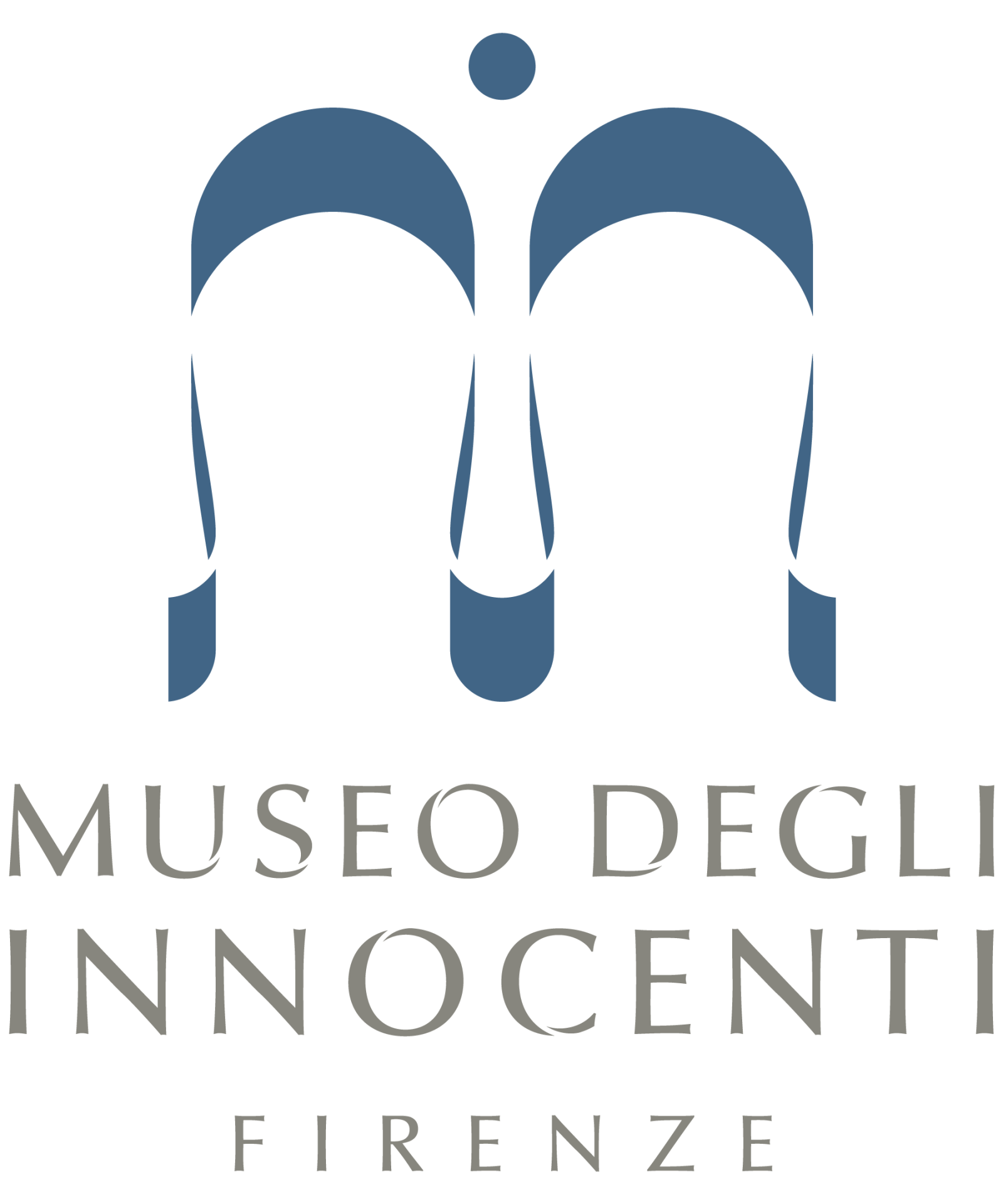Art
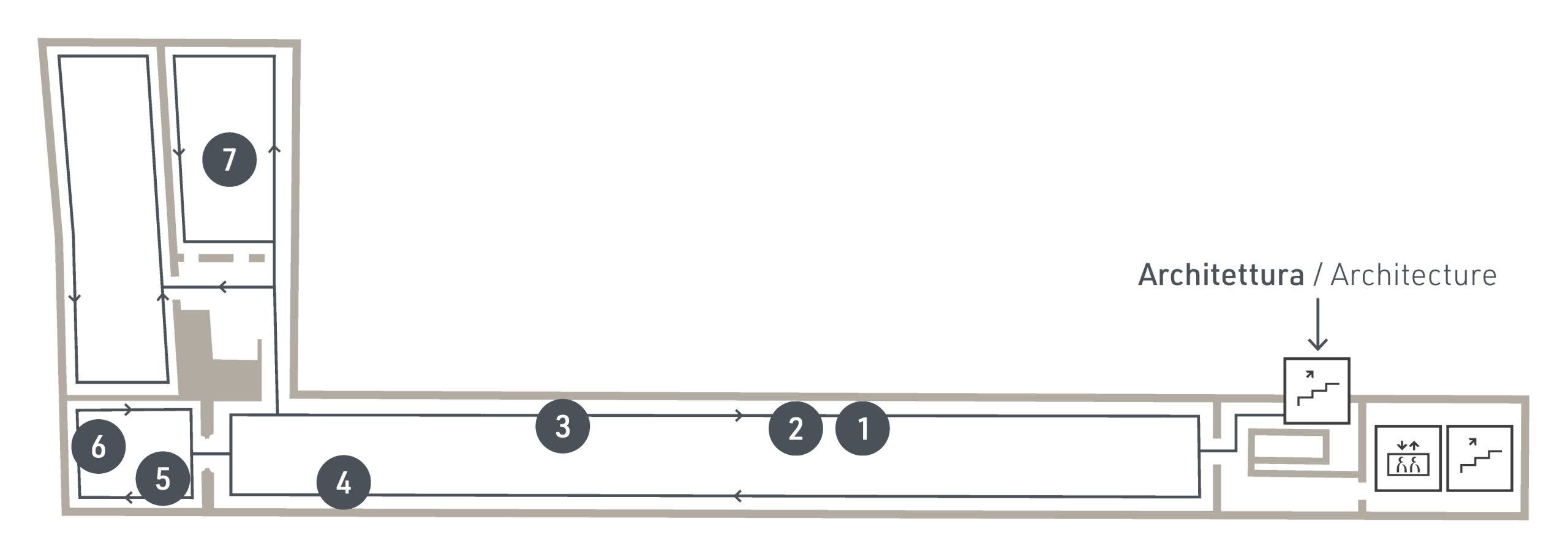
Art Gallery
It houses a rich collection of artworks that are closely related to the history of the institution. Most were commissioned by the hospital, while the others were acquired through donations or as a result of the integration of other welfare institutions. Built between 1436 and 1438 by Francesco Della Luna, the Pinacoteca consists of a large space with a trussed roof, a room dedicated to altarpieces from the church of Santa Maria degli Innocenti, and the spaces of the Coretto.
The collection includes masterpieces by great masters, such as Domenico Ghirlandaio, Luca and Andrea della Robbia, Sandro Botticelli and Piero di Cosimo, as well as works by artists who grew up in the hospital and were initiated into painting by Prior Vincenzo Borghini, such as Vincenzo Ulivieri, Giovan Battista Naldini and Francesco Morandini, known as Poppi.
The Nurses' Prayer Coretto houses a splendid collection of tabernacles and clothed sculptures, which are related to the devotional practices carried out within the Innocenti.
The collection includes masterpieces by great masters, such as Domenico Ghirlandaio, Luca and Andrea della Robbia, Sandro Botticelli and Piero di Cosimo, as well as works by artists who grew up in the hospital and were initiated into painting by Prior Vincenzo Borghini, such as Vincenzo Ulivieri, Giovan Battista Naldini and Francesco Morandini, known as Poppi.
The Nurses' Prayer Coretto houses a splendid collection of tabernacles and clothed sculptures, which are related to the devotional practices carried out within the Innocenti.
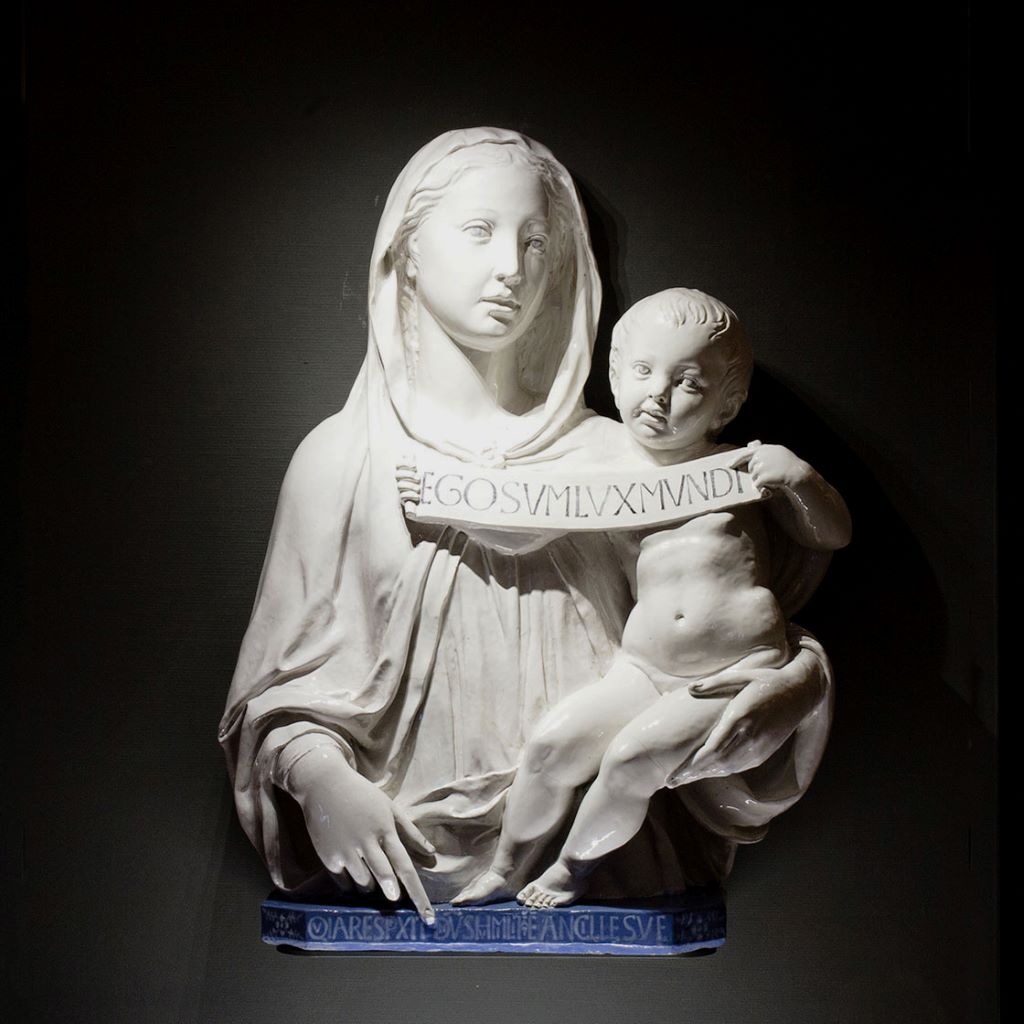
1
Luca della Robbia
Madonna and Child, 1445-1450 approx.
Glazed earthenware; 76 × 58 cm
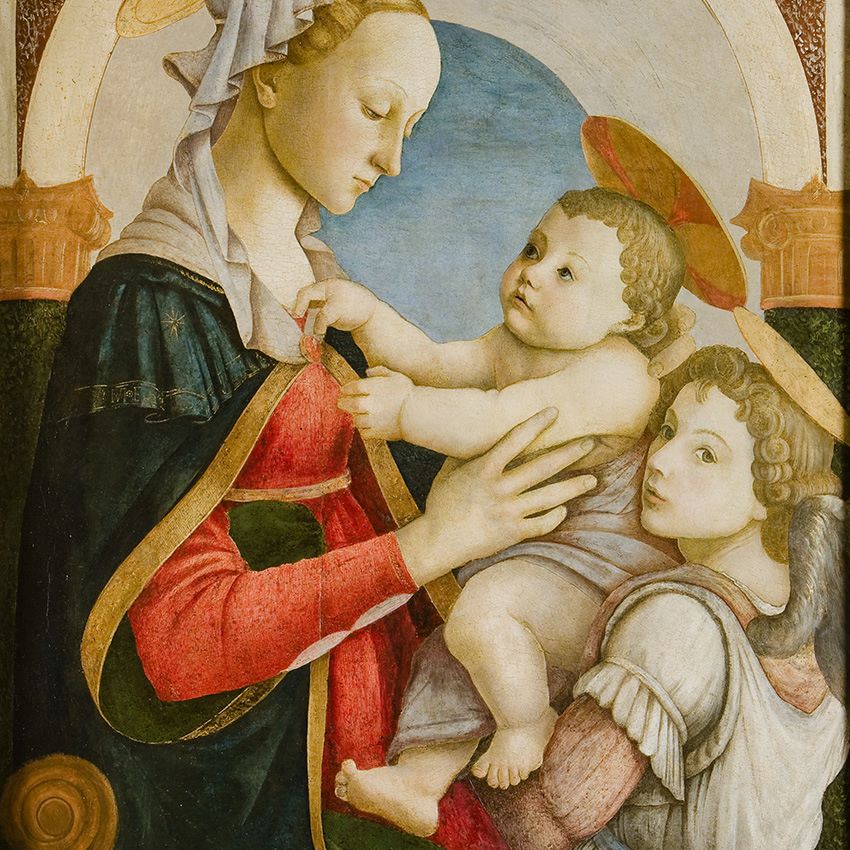
2
Sandro Botticelli
Madonna and Child with an angel, c. 1465
Tempera on panel; 69 × 64 cm
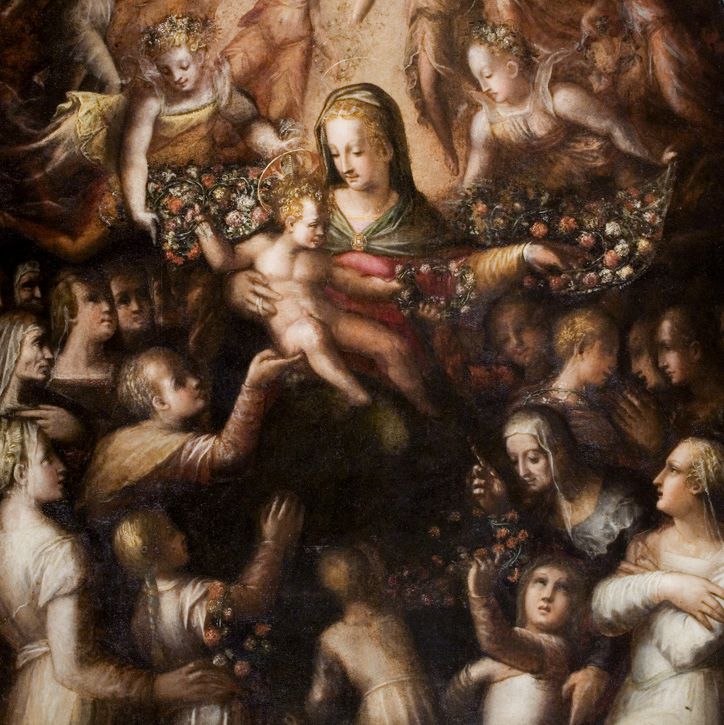
3
Francesco Morandini known as "Il Poppi"
Madonna Enthroned with Child and Angels, venerated by Nocentine, 1565-1566
Oil on panel; 177 × 117 cm
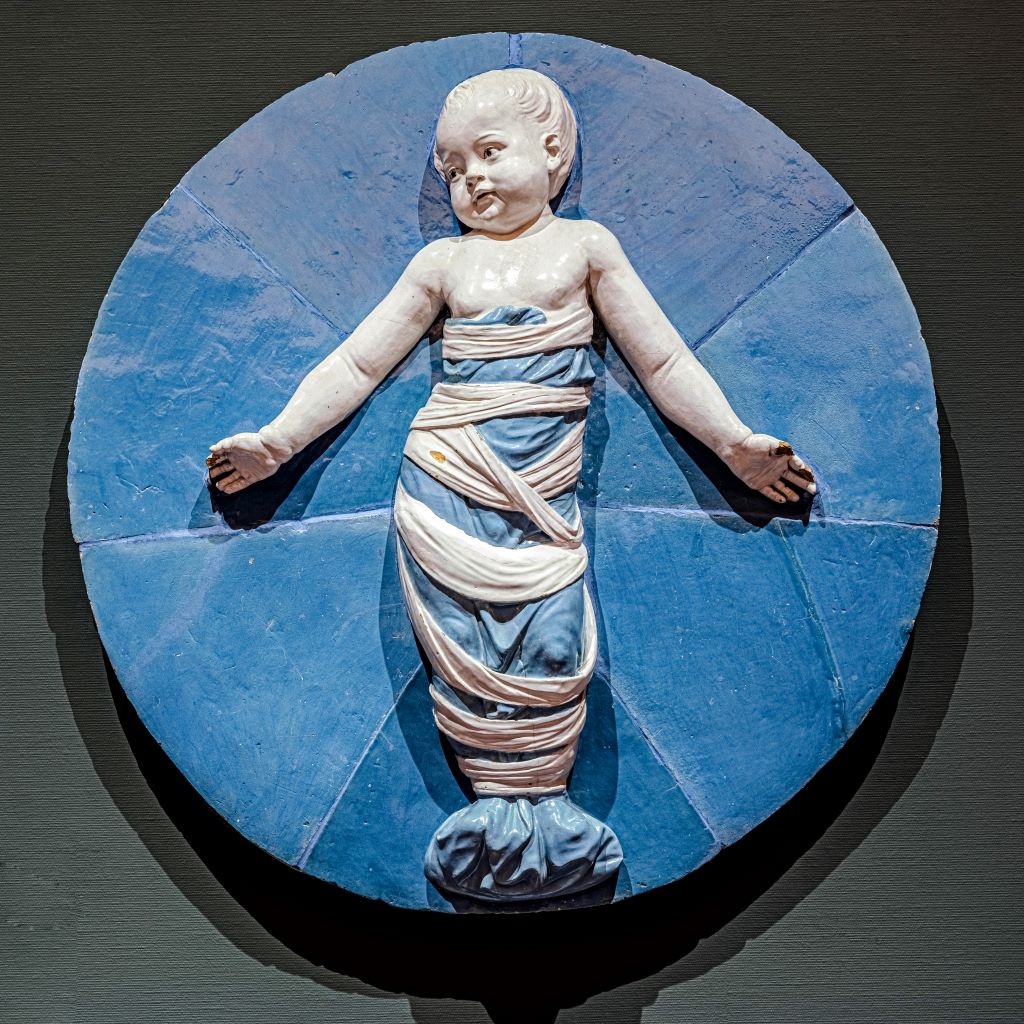
4
Andrea della Robbia
Putti in Fasces, 1487
Glazed terracotta; ø cm 100 each approx.
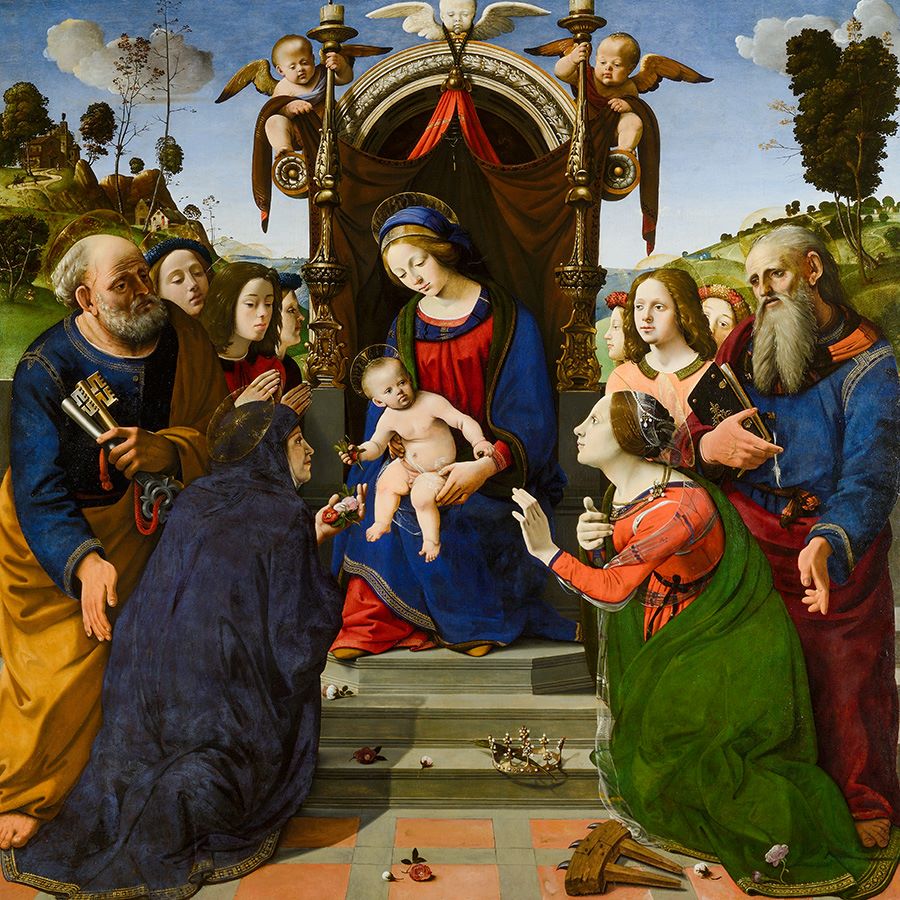
5
Piero di Cosimo
Enthroned Madonna and Child with Saints Peter, John the Evangelist, Elizabeth of Hungary (?), Catherine of Alexandria and angels, 1493
Tempera on panel; 203 × 198 cm
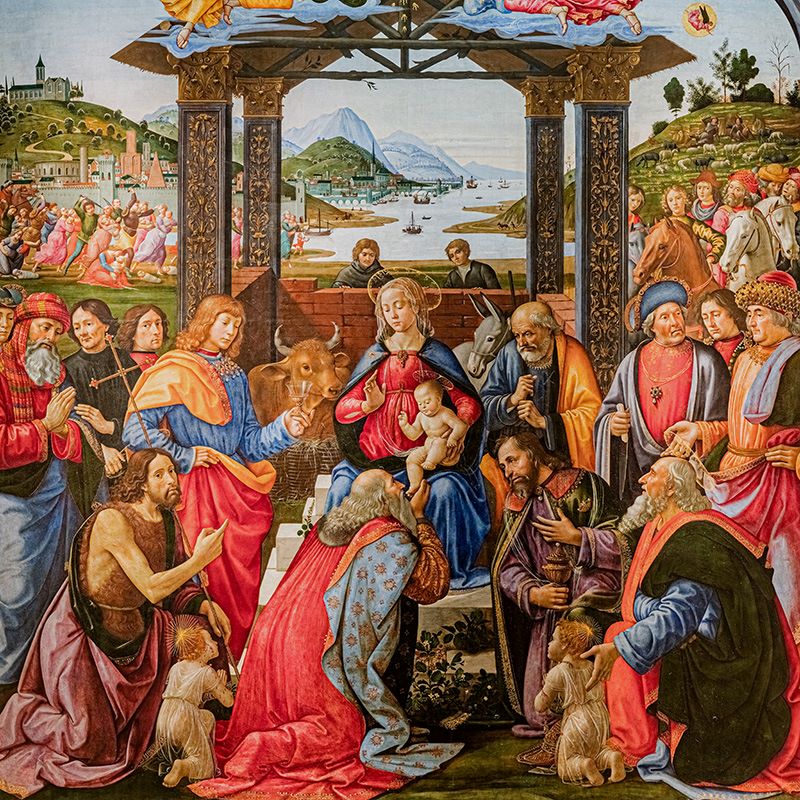
6
Domenico Ghirlandaio
Adoration of the Magi, 1488-89
Tempera and oil on panel; 285 × 240 cm
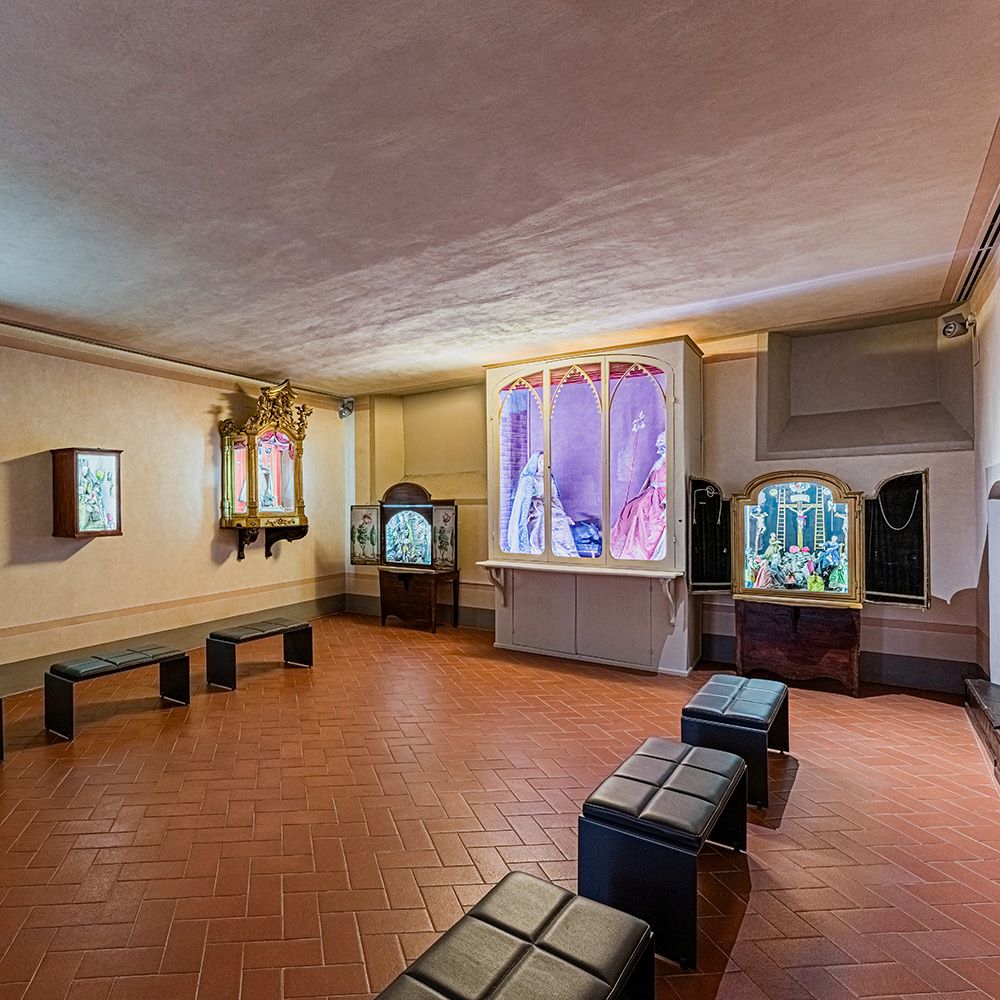
7
The Choir
1
Luca della Robbia
Madonna and Child, 1445-1450 approx.
Glazed earthenware; 76 × 58 cm
Admirably executed by Luca della Robbia, it was located in the small women's church and is perhaps among the earliest works commissioned for the Innocenti. The glazed terracotta, an invention of the artist, gives the work an almost supernatural luster.
The Virgin Mary holds Jesus in her arms while pointing to a verse from the Magnificat, a canticle sung during Mary's meeting with Elizabeth, in which reference is made to her being the Lord's humble servant. It is one of the few Gospel accounts of her voice that perhaps refers to the humble origins of the many girls who lived in the Hospital.
The Virgin Mary holds Jesus in her arms while pointing to a verse from the Magnificat, a canticle sung during Mary's meeting with Elizabeth, in which reference is made to her being the Lord's humble servant. It is one of the few Gospel accounts of her voice that perhaps refers to the humble origins of the many girls who lived in the Hospital.
Back to the works

2
Madonna and Child and an angel
Sandro Botticelli (c. 1465)
Tempera on panel; 69 × 64 cm
Tempera on panel; 69 × 64 cm

Admirably executed by Luca della Robbia, it was located in the small women's church and is perhaps among the earliest works commissioned for the Innocenti. The glazed terracotta, an invention of the artist, gives the work an almost supernatural luster.
The Virgin Mary holds Jesus in her arms while pointing to a verse from the Magnificat, a canticle sung during Mary's meeting with Elizabeth, in which reference is made to her being the Lord's humble servant. It is one of the few Gospel accounts of her voice that perhaps refers to the humble origins of the many girls who lived in the Hospital.
The Virgin Mary holds Jesus in her arms while pointing to a verse from the Magnificat, a canticle sung during Mary's meeting with Elizabeth, in which reference is made to her being the Lord's humble servant. It is one of the few Gospel accounts of her voice that perhaps refers to the humble origins of the many girls who lived in the Hospital.
Back to the works
2
Sandro Botticelli
Madonna and Child with an angel, c. 1465
Tempera on panel; 69 × 64 cm
An early work by Sandro Botticelli, it is inspired by Filippo Lippi's famous Madonna and Child with Two Angels, now housed in the Uffizi Galleries. Acquired by the Hospital in the mid-19th century, it is one of the most significant pieces in the collection.
The Madonna is depicted in the gesture of welcoming Jesus into her arms, supported by an angel whose gaze draws the viewer into the scene. Mary is pensive, as if aware of the fate of the Child, who instead seems carefree and busy holding out his hands toward his mother. The scene is engaging and intimate, prompting the viewer to notice only later that the perspective point of view of the architecture in the background is slightly lowered from that of the rest of the composition.
The Madonna is depicted in the gesture of welcoming Jesus into her arms, supported by an angel whose gaze draws the viewer into the scene. Mary is pensive, as if aware of the fate of the Child, who instead seems carefree and busy holding out his hands toward his mother. The scene is engaging and intimate, prompting the viewer to notice only later that the perspective point of view of the architecture in the background is slightly lowered from that of the rest of the composition.
Back to the works

2
Madonna and Child and an angel
Sandro Botticelli (c. 1465)
Tempera on panel; 69 × 64 cm
Tempera on panel; 69 × 64 cm

An early work by Sandro Botticelli, it is inspired by Filippo Lippi's famous Madonna and Child with Two Angels, now housed in the Uffizi Galleries. Acquired by the Hospital in the mid-19th century, it is one of the most significant pieces in the collection.
The Madonna is depicted in the gesture of welcoming Jesus into her arms, supported by an angel whose gaze draws the viewer into the scene. Mary is pensive, as if aware of the fate of the Child, who instead seems carefree and busy holding out his hands toward his mother. The scene is engaging and intimate, prompting the viewer to notice only later that the perspective point of view of the architecture in the background is slightly lowered from that of the rest of the composition.
The Madonna is depicted in the gesture of welcoming Jesus into her arms, supported by an angel whose gaze draws the viewer into the scene. Mary is pensive, as if aware of the fate of the Child, who instead seems carefree and busy holding out his hands toward his mother. The scene is engaging and intimate, prompting the viewer to notice only later that the perspective point of view of the architecture in the background is slightly lowered from that of the rest of the composition.
Back to the works
3
Francesco Morandini known as "Il Poppi"
Madonna Enthroned with Child and Angels, venerated by Nocentine, 1565-1566
Oil on panel; 177 × 117 cm
The panel depicts the Virgin surrounded by little girls, maidens, young girls and old women, clearly referring to the Hospital's growing female community.
The veiled figure in dark robes could be the abbess who oversaw the life of this section of the Hospital. The floral wreaths could represent a reference to the paper flowers made by the Nocentine women, still preserved in the tabernacles displayed in the rooms of the choir.
It is recorded among Poppi's works kept at the Innocenti in the section "where the women are" and probably with that "of the church of our women," paid to Poppi by the Hospital between March 1565 and March 22, 1567. This is the first known proof of the artist, then in his twenties, commissioned by his patron Vincenzo Borghini.
The veiled figure in dark robes could be the abbess who oversaw the life of this section of the Hospital. The floral wreaths could represent a reference to the paper flowers made by the Nocentine women, still preserved in the tabernacles displayed in the rooms of the choir.
It is recorded among Poppi's works kept at the Innocenti in the section "where the women are" and probably with that "of the church of our women," paid to Poppi by the Hospital between March 1565 and March 22, 1567. This is the first known proof of the artist, then in his twenties, commissioned by his patron Vincenzo Borghini.
Back to the works

3
Madonna Enthroned with Child and Angels, venerated by Nocentines
Francesco Morandini known as "Il Poppi" (1565-1566)
Oil on panel; 177 × 117 cm
Oil on panel; 177 × 117 cm

The panel depicts the Virgin surrounded by little girls, maidens, young girls and old women, clearly referring to the Hospital's growing female community.
The veiled figure in dark robes could be the abbess who oversaw the life of this section of the Hospital. The floral wreaths could represent a reference to the paper flowers made by the Nocentine women, still preserved in the tabernacles displayed in the rooms of the choir.
It is recorded among Poppi's works kept at the Innocenti in the section "where the women are" and probably with that "of the church of our women," paid to Poppi by the Hospital between March 1565 and March 22, 1567. This is the first known proof of the artist, then in his twenties, commissioned by his patron Vincenzo Borghini.
The veiled figure in dark robes could be the abbess who oversaw the life of this section of the Hospital. The floral wreaths could represent a reference to the paper flowers made by the Nocentine women, still preserved in the tabernacles displayed in the rooms of the choir.
It is recorded among Poppi's works kept at the Innocenti in the section "where the women are" and probably with that "of the church of our women," paid to Poppi by the Hospital between March 1565 and March 22, 1567. This is the first known proof of the artist, then in his twenties, commissioned by his patron Vincenzo Borghini.
Back to the works
4
Andrea della Robbia
Putti in Fasces, 1487
Glazed terracotta; ø cm 100 each approx.
In 1487, the ten figures of Putti in bands were inserted into the oculi above the loggia on Filippo Brunelleschi's facade. Two of them are on display in the gallery for conservation reasons, following the major restoration masterfully carried out by the Opificio delle Pietre dure between 2015 and 2016. Their presence in the collection allows visitors to be able to observe them up close, admire their finesse of execution as well as their real size that cannot be perceived from the square.
They are made with the glazed terracotta technique, which is optimal for remaining in the weather without being damaged. This is evidenced by the more than six centuries of permanence outside in good condition. Andrea depicts the putti with a serene gaze, some in the act of freeing themselves from their swaddling clothes. The white bodies of the children stand out against the cobalt blue background. The image of Putti in swaddling clothes has become the symbol of the Hospital over time.
They are made with the glazed terracotta technique, which is optimal for remaining in the weather without being damaged. This is evidenced by the more than six centuries of permanence outside in good condition. Andrea depicts the putti with a serene gaze, some in the act of freeing themselves from their swaddling clothes. The white bodies of the children stand out against the cobalt blue background. The image of Putti in swaddling clothes has become the symbol of the Hospital over time.
Back to the works

4
Putti in Bands
Andrea della Robbia (1487)
Glazed terracotta; ø about 100 cm each
Glazed terracotta; ø about 100 cm each

In 1487, the ten figures of Putti in bands were inserted into the oculi above the loggia on Filippo Brunelleschi's facade. Two of them are on display in the gallery for conservation reasons, following the major restoration masterfully carried out by the Opificio delle Pietre dure between 2015 and 2016. Their presence in the collection allows visitors to be able to observe them up close, admire their finesse of execution as well as their real size that cannot be perceived from the square.
They are made with the glazed terracotta technique, which is optimal for remaining in the weather without being damaged. This is evidenced by the more than six centuries of permanence outside in good condition. Andrea depicts the putti with a serene gaze, some in the act of freeing themselves from their swaddling clothes. The white bodies of the children stand out against the cobalt blue background. The image of Putti in swaddling clothes has become the symbol of the Hospital over time.
They are made with the glazed terracotta technique, which is optimal for remaining in the weather without being damaged. This is evidenced by the more than six centuries of permanence outside in good condition. Andrea depicts the putti with a serene gaze, some in the act of freeing themselves from their swaddling clothes. The white bodies of the children stand out against the cobalt blue background. The image of Putti in swaddling clothes has become the symbol of the Hospital over time.
Back to the works
5
Piero di Cosimo
Enthroned Madonna and Child with Saints Peter, John the Evangelist, Elizabeth of Hungary (?), Catherine of Alexandria and angels, 1493
Tempera on panel; 203 × 198 cm
This is one of the Innocenti's most important works, commissioned by Piero del Pugliese for the altar of the family chapel. The scene depicts a Sacred Conversation, surrounded by wingless angels, and the Mystic Marriage of St. Catherine.
The link with the Hospital is underscored by the presence of St. Peter, protector of the commissioner, presenting an elderly saint, probably St. Elizabeth of Hungary, to whom the chapel was dedicated. St. John the Evangelist, patron of the Silk Art, presents St. Catherine of Alexandria in the act of receiving a ring from Jesus.
The link with the Hospital is underscored by the presence of St. Peter, protector of the commissioner, presenting an elderly saint, probably St. Elizabeth of Hungary, to whom the chapel was dedicated. St. John the Evangelist, patron of the Silk Art, presents St. Catherine of Alexandria in the act of receiving a ring from Jesus.
Back to the works

5
Enthroned Madonna and Child with Saints Peter, John the Evangelist, Elizabeth of Hungary (?), Catherine of Alexandria and angels
Piero di Cosimo (1493)
Tempera on panel; 203 × 198 cm
Tempera on panel; 203 × 198 cm

This is one of the Innocenti's most important works, commissioned by Piero del Pugliese for the altar of the family chapel. The scene depicts a Sacred Conversation, surrounded by wingless angels, and the Mystic Marriage of St. Catherine.
The link with the Hospital is underscored by the presence of St. Peter, protector of the commissioner, presenting an elderly saint, probably St. Elizabeth of Hungary, to whom the chapel was dedicated. St. John the Evangelist, patron of the Silk Art, presents St. Catherine of Alexandria in the act of receiving a ring from Jesus.
The link with the Hospital is underscored by the presence of St. Peter, protector of the commissioner, presenting an elderly saint, probably St. Elizabeth of Hungary, to whom the chapel was dedicated. St. John the Evangelist, patron of the Silk Art, presents St. Catherine of Alexandria in the act of receiving a ring from Jesus.
Back to the works
6
Domenico Ghirlandaio
Adoration of the Magi, 1488-89
Tempera and oil on panel; 285 × 240 cm
A work of extraordinary artistic and narrative value, it evokes much of the Institution's history. The patronage is represented by Prior Francesco Tesori and richly dressed figures, probably portraits of Silk Art personalities. The painter signs the work with his self-portrait.
The scene is attended by kneeling St. John the Baptist, patron saint of Florence, and St. John the Evangelist, patron saint of the Art, along with two young martyrs of the Massacre of the Innocents. The presence of men at work possibly indicates the building of the Hospital.
The scene is attended by kneeling St. John the Baptist, patron saint of Florence, and St. John the Evangelist, patron saint of the Art, along with two young martyrs of the Massacre of the Innocents. The presence of men at work possibly indicates the building of the Hospital.
Back to the works

6
Adoration of the Magi
Domenico Ghirlandaio (1488-89)
Tempera and oil on board; 285 × 240 cm
Tempera and oil on board; 285 × 240 cm

A work of extraordinary artistic and narrative value, it evokes much of the Institution's history. The patronage is represented by Prior Francesco Tesori and richly dressed figures, probably portraits of Silk Art personalities. The painter signs the work with his self-portrait.
The scene is attended by kneeling St. John the Baptist, patron saint of Florence, and St. John the Evangelist, patron saint of the Art, along with two young martyrs of the Massacre of the Innocents. The presence of men at work possibly indicates the building of the Hospital.
The scene is attended by kneeling St. John the Baptist, patron saint of Florence, and St. John the Evangelist, patron saint of the Art, along with two young martyrs of the Massacre of the Innocents. The presence of men at work possibly indicates the building of the Hospital.
Back to the works
7
The Choir
In the sixteenth century, the growth of the women's community leads to the construction of a new raised room beyond today's Via della Colonna to house the looms used by the weaving maidens. It is referred to as a large room for the drapery loom.
In the seventeenth century, the same room became the girls' dormitory and then a place for the nannies. The nearby coretto was a protected place, dedicated to the women of the house who did not have access to the main church and allowed them to follow Holy Mass from above without being the object of prying eyes from the male community.
In the seventeenth century, the same room became the girls' dormitory and then a place for the nannies. The nearby coretto was a protected place, dedicated to the women of the house who did not have access to the main church and allowed them to follow Holy Mass from above without being the object of prying eyes from the male community.
Back to the works

7
The Choir
Francesco Morandini known as "Il Poppi" (1565-1566)
oil on panel; 177 × 117 cm
oil on panel; 177 × 117 cm

In the sixteenth century, the growth of the women's community leads to the construction of a new raised room beyond today's Via della Colonna to house the looms used by the weaving maidens. It is referred to as a large room for the drapery loom.
In the seventeenth century, the same room became the girls' dormitory and then a place for the nannies. The nearby coretto was a protected place, dedicated to the women of the house who did not have access to the main church and allowed them to follow Holy Mass from above without being the object of prying eyes from the male community.
In the seventeenth century, the same room became the girls' dormitory and then a place for the nannies. The nearby coretto was a protected place, dedicated to the women of the house who did not have access to the main church and allowed them to follow Holy Mass from above without being the object of prying eyes from the male community.
Back to the works
